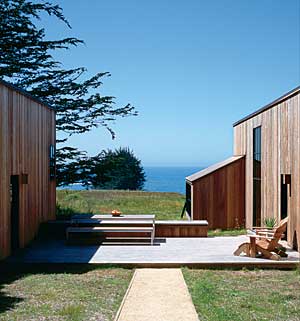Sea Ranch, CA
Turnbull Griffin Haesloop Architects
Steep cliffs, crashing waves, and wild natural beauty characterize the coastal enclave of The Sea Ranch, 90 miles north of San Francisco. Even in summer, rolling fog and mist are more likely than sun, and the chilly onshore wind is a predictable afternoon visitor. As a result, houses here tend to be contained boxes with large windows and cozy fireplaces. Life takes place inside after brisk walks along the cliff tops or sweater-clad investigations of the pocket beaches. In the open meadows nearest the sea, most outdoor spaces consist of either inward-looking courtyards, gardens carefully sheltered by house or fence, or decks that embrace the view but are fitted with high glass walls.
It comes as a surprise, then, that the carefully composed Evans House sits on the bluffs at Sea Ranch. This compound of three modest buildings—a living/dining-room building, a master-bedroom suite, and a garage/studio building—with outdoor spaces connecting them, defies the pattern here. An unenclosed deck, with a view of the adjacent coastal meadow and the Pacific horizon, lies at its center. Across the yard on the landward side, the one-car garage and tiny studio combine to make a third building that straddles the redwood fence hiding the house from the road.
The house’s focus around exposed outdoor space is not a result of naïveté about the conditions at Sea Ranch; in fact, quite the opposite. The architects, Turnbull Griffin Haesloop (TGH), are among those most familiar with the place. William Turnbull, who died in 1997, was the T in MLTW, the firm that in 1964 designed the progenitor of all Sea Ranch buildings, Sea Ranch Condominium 1. When MLTW dispersed, Turnbull stayed in San Francisco, and the firm now has dozens of Sea Ranch houses to its credit. “Our early buildings at The Sea Ranch were sealed like spaceships due to the wind and weather. “ says partner Mary Griffin, FAIA. “But we are now learning to compose buildings so that people can live outside.”
The slightly sloped site features a line of mature cypress trees along its eastern edge and, to the west, a dense thicket of native scrub planted by the neighbors to maintain privacy. “Our first instinct was to push the house as close to the cliff as the lot would allow,” partner Eric Haesloop, AIA, recalls. “But we quickly discovered that by setting the buildings back, views of the houses on either side could be minimized.”



Post a comment to this article
Report Abusive Comment